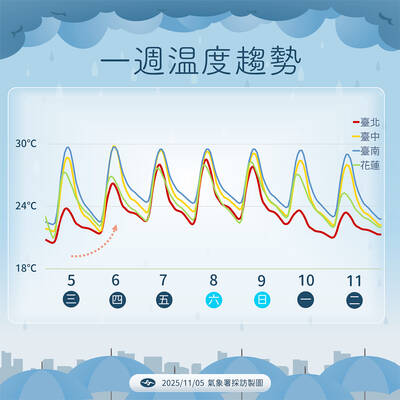Google Taiwan on Wednesday displayed a Google Doodle on its Taiwan portal to mark the 115th birthday of Chen Chin (陳進, 1907-1998), widely recognized as Taiwan’s first female commercial painter.
Born into an affluent family in Hsinchu, Chen began painting under the tutelage of Koto Gohara at Taipei Third Girls’ Senior High School, which today is Taipei Municipal Zhongshan Girls’ High School.
She later became the first female Taiwanese artist to study in Japan when she enrolled at the Tokyo Women’s Academy of Fine Arts in 1925.
Chen was one of three Taiwanese artists among 92 selected to exhibit at the first Taiwan Art Exhibition (Taiten) in 1927 during the Japanese colonial era, the other two being Kuo Hsueh-hu (郭雪湖) and Lin Yu-shan (林玉山).
The trio — dubbed the “Three Youths of Taiten” as they were all 19 at the time — went on to have long and illustrious careers.
Chen’s paintings were displayed at Taiten for 10 years in a row, earning her the title of the exhibition’s “reviewless painter.”
From 1934 to 1938, Chen taught art at Takao Prefecture Heito High School for Girls, which is Pingtung Girls’ Senior High School today, the first Taiwanese woman to teach at a Japanese colonial-era high school.
In 1935, Chen again made headlines when the Imperial Fine Arts Academy Exhibition in Tokyo displayed her painting Ensemble, which depicts two women dressed in typical 1930s Taiwanese upper-class style.
She returned to Taiwan for good in 1945 and in 1946 served as a juror for the first Taiwan Provincial Fine Arts Exhibition.
She remained active in Taiwan’s art community, holding solo exhibitions and forming painting groups.
Her artwork continued to be celebrated in Taiwanese art circles, and in 1986 the Taipei Fine Arts Museum curated and exhibited 80 of her paintings to mark her 80th birthday.
The “Three Youths of Taiten” reunited in 1987 for a joint exhibition at the East Gallery in Taipei.
Specializing in Eastern gouache, also known as nihonga, Chen is best known for her earlier works depicting upper-class women from the first half of the 20th century. Her works are often described as having finessed, expressive brushstrokes and a “mellow” aesthetic.
“By studying Chen’s numerous paintings in chronological order, one can trace two separate histories at once — that of Taiwan’s and that of Chen’s personal growth,” the Ministry of Culture says on its Web site on a page dedicated to Chen. “From demure women with their eyes downcast to high-spirited individuals coasting on bicycles, women’s expanding role in Taiwanese society can be witnessed in Chen’s scrolls of silk.”
“Her choice of subjects over the years also varied to reflect her roles as an independent artist, a loving wife and a doting mother,” it says.
In 1996, Chen won the National Cultural Award, along with prize money of NT$600,000 (US$18,642).
The following year she donated the money — along with NT$400,000 from her savings — to launch the Chen Chin Arts and Culture Award.
The program still receives funding from the interest generated by Chen’s NT$1 million endowment.

Three Taiwanese airlines have prohibited passengers from packing Bluetooth earbuds and their charger cases in checked luggage. EVA Air and Uni Air said that Bluetooth earbuds and charger cases are categorized as portable electronic devices, which should be switched off if they are placed in checked luggage based on international aviation safety regulations. They must not be in standby or sleep mode. However, as charging would continue when earbuds are placed in the charger cases, which would contravene international aviation regulations, their cases must be carried as hand luggage, they said. Tigerair Taiwan said that earbud charger cases are equipped

Foreign travelers entering Taiwan on a short layover via Taiwan Taoyuan International Airport are receiving NT$600 gift vouchers from yesterday, the Tourism Administration said, adding that it hopes the incentive would boost tourism consumption at the airport. The program, which allows travelers holding non-Taiwan passports who enter the country during a layover of up to 24 hours to claim a voucher, aims to promote attractions at the airport, the agency said in a statement on Friday. To participate, travelers must sign up on the campaign Web site, the agency said. They can then present their passport and boarding pass for their connecting international

UNILATERAL MOVES: Officials have raised concerns that Beijing could try to exert economic control over Kinmen in a key development plan next year The Civil Aviation Administration (CAA) yesterday said that China has so far failed to provide any information about a new airport expected to open next year that is less than 10km from a Taiwanese airport, raising flight safety concerns. Xiamen Xiangan International Airport is only about 3km at its closest point from the islands in Kinmen County — the scene of on-off fighting during the Cold War — and construction work can be seen and heard clearly from the Taiwan side. In a written statement sent to Reuters, the CAA said that airports close to each other need detailed advanced

UNKNOWN TRAJECTORY: The storm could move in four possible directions, with the fourth option considered the most threatening to Taiwan, meteorologist Lin De-en said A soon-to-be-formed tropical storm east of the Philippines could begin affecting Taiwan on Wednesday next week, the Central Weather Administration (CWA) said yesterday. The storm, to be named Fung-wong (鳳凰), is forecast to approach Taiwan on Tuesday next week and could begin affecting the weather in Taiwan on Wednesday, CWA forecaster Huang En-hung (黃恩鴻) said, adding that its impact might be amplified by the combined effect with the northeast monsoon. As of 2pm yesterday, the system’s center was 2,800km southeast of Oluanbi (鵝鑾鼻). It was moving northwest at 18kph. Meteorologist Lin De-en (林得恩) on Facebook yesterday wrote that the would-be storm is surrounded by